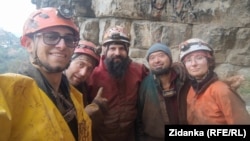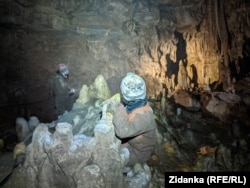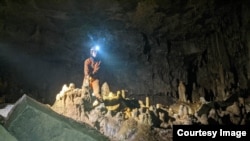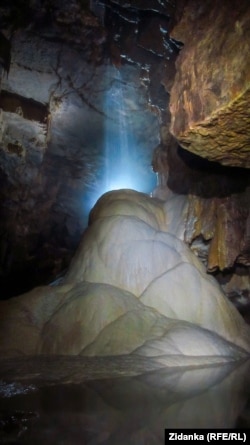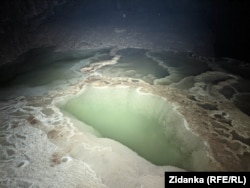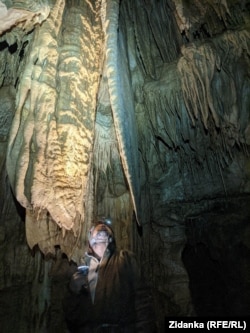Though they explore caves for fun, these Bulgarian enthusiasts have been hailed for making the "discovery of the year" in speleology. Now their mission is to preserve its splendor.
The cave explorers (pictured above from left to right) Simeon Nenkov, Georgi Nenchev, Stanislav Asenov, Konstantin Stoichkov, and Slaveya Kostadinova discovered a beautiful hall within the cave complex of the Iskar Gorge of Stara Planina near Lakatnik, Bulgaria.
They investigated the often-overlooked entrance to the Zidanka cave that is located 15 meters from the entry point to one of the more famous and visited caves called Temnata Dupka.
Small, dusty, and nondescript, the Zidanka entrance was passed over by speleologists and cavers for decades.
That was until the five enthusiasts delved deeper into Zidanka to discover an unknown and surprisingly beautiful section of the cave.
The region is riddled with caverns and grottos due to the large amount of underground water that flows up into the Zhitolyub spring and the Iskar River. The underground cavities and galleries in the area are connected by a huge cave system.
On Hands And Knees
Little by little, they slowly crawled deeper and deeper, opening up tight spaces and removing dangerous rock fragments. They were aided by a robot that Asenov invented, which he calls his "selfie stick."
The device resembles a seven-meter rod with a head mounted on top that can rotate in all directions and contains a high-resolution camera, a light, and several types of sensors, including lasers and ultrasonic sensors for measuring distances.
After a dozen visits and over 100 hours of hard work, the spelunkers managed to clear the mass of rocks that blocked Zidanka.
Kostadinova called the place where they dug "hopeless." She added, "All day I thought I was doing first-class labor for no money and that I was very stupid for it. That's until we discovered the new part."
"We knew from the mapping that after a number of meters it would reach a place in Temnata Dupka, which cavers can reach in about two hours from its entrance," Stoichkov said.
The Zidanka and Temnata Dupka caves are part of a large cavern system that was cut off by debris from a collapse. After entering Zidanka, the five explorers thought they had come to a dead end with no way to cross the last 8 meters to Temnata Dupka.
It was there they noticed a crack in the ceiling. Nenkov managed to climb up to it, some 4-5 meters up the rockface. The rift led to a dead end, where he lingered for a moment before returning to the others.
"I felt a slight draft, which is a sure sign that there is a cavity. I checked with my breath to see that air was coming out from somewhere."
Nenkov then crawled as far as possible into the narrow alcove, and above his head he saw a small space through which he could crawl. After a few more meters, the black space of the new hall opened up before his eyes.
"I expected to see the same as before -- mud, stones, narrow openings -- but a total surprise opened up," he said.
The hall was white and huge, measuring 72 meters long, 17 meters wide, and 15 meters high. Kostadinova described it as "surreal." Unlike the other caves in the area, the Zidanka hall abounds with all kinds of secondary cave formations, such as stalactites, stalagmites, draperies, and crystals.
Its entire floor is dotted with small and large calcite pools. A waterfall flows from the ceiling, leaving deposits that form a towering white stalagmite before flowing into other parts of the cave.
Aleksey Zhalov from the management board of the Bulgarian Cave Society told RFE/RL that the new find at Zidanka is "the discovery of the year."
For Nenkov, "The feeling of penetrating where no human has ever set foot is incomparable to anything else, to the exclusion of all other sensations known to mankind. Perhaps only astronauts can experience it nowadays." He named the hall Kosyo Kasabov, after the late respected caver and caving instructor.
After its discovery, the problem now is keeping the site from becoming damaged. By entering the hall, one must walk through the deep, sticky mud, followed by fragile snow-white formations that can easily become damaged or dirty.
Another problem is that now that word is out about the cave, people with little experience can actually reach it.
"In the absence of legal protection for the caves, we have to protect them ourselves," Stoichkov said.
"We ask everyone who visits the hall to follow only the well-trodden path, clean their shoes of mud in advance, and make an effort to keep the hall beautiful," wrote members of the team in the club diaries, which describe the discovery day by day.
The cavers' new goal is to find a way to connect Zidanka and Temnata Dupka.
"Caving will never be just a hobby," Kostadinova said.




